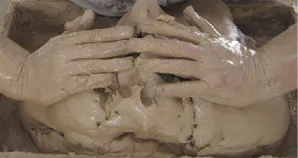The evolution of the human hand
I have been fascinated by the emerging scientific research about the vast overlapping worlds of sensorimotor and cognitive functions. Since Work at the Clay Field involves continuous, intricate observation of the movements of the hands in the clay, in the symbolic world of the field, I would like to begin this discussion by briefly looking at the astounding evolution of the hand. The anthropological and evolutionary history of the development of our hands reads like a neurological thriller.
Without much scientific evidence, but by following my intuition, I would suggest for many years to clients sitting in front of a sheet of paper or at the Clay Field: “Follow your hands! Your hands know the way; in your head you will just stay in the known; in order to explore the unknown and find new ground, you need to trust your hands and follow the impulses in them.” This approach had always worked for me as an artist. To begin a process, I experimented with my hands and then came to emotional and cognitive insights. Whenever I had a rational plan and then sat down to paint or draw it, I was blocked and ended up frustrated. So I learned to trust my hands. We now hear from neurologists, paleoanthropologists and hand surgeons that the hand has been instrumental in shaping the human brain; that our capacity for language and human culture stems from the use of our hands. These scientists expose the hidden physical roots of the unique human capacity for passionate creative work (Deuser 2009; Donald 1991; Schmidt and Lanz 2004; Wilson 1998). I had actually intuitively followed the age-old evolutionary steps.
The human use of the hand is unmatched in the animal world. And yet the human hand continues to exhibit a number of primitive characteristics. The hand evolved from the pectoral fin and its origin antedates that of the arm. The “primeval hand” is therefore older than man, its form and structure dating back approximately 250 million years. The unspecialized hand is also older than the human brain. Only the evolution of the central nervous system as a control organ during the last 500,000 years has turned the hand into the human hand in its present form (Schmidt and Lanz 2004).
According to current knowledge, the prehensile hand of the primates, including humans, developed from the mobile hand of semi-tree-dwelling insectivores about 100 million years ago (Napier 1956). A distinctive feature of primate evolution has been the development of prehensile hands and feet in adaptation to living in treetops; hands and feet that could grasp things and handle simple tools. These progressive adaptional changes have been accompanied by structural changes in the brain. The eyes of the ape moved inward to the front of the face. The resulting binocular vision allowed the visual fields to overlap and produce a perception of depth. Stereoscopic vision has been instrumental in refining primates’ ability to negotiate movement from branch to branch up in the trees and enabled them to grasp objects. At the same time, the jaw moved backward and was no longer the key combat tool (Wilson 1998).
Of the first “southern apes” that walked upright, “Lucy,” who lived 3.2 million years ago in Hadar in eastern Africa, is the best known. Her discovery created a sensation in the anthropological world. She was the first bipedal human ancestor to be discovered, and she had an un-ape-like hand and a chimpanzee-sized brain (Wilson 1998). Lucy’s hand still can’t turn the wrist, nor can her thumb meet her fingertips. The erect posture, however, acquired by the first Australian human ancestors approximately three million years ago, was a milestone in adaptation. Gradually the hand was freed from the task of locomotion. Wilson speculates that we may have turned into kangaroo-type creatures with withered upper extremities once the knuckle-walk and hanging from branches was no longer required. If this did happen, such species did not survive.
These hominids were the earliest gourmets. They had become used to a varied diet of meat, fruits, flowers, nuts and honey in the then abundant treetops. When climate change forced them out into the open, they would have had little inclination for a boring grazing diet. Survival in the savannah, though, was tough and required new skills. The strong arms that had developed for weight-bearing in the treetops were now encouraging the use of tools. Lucy’s descendants had to learn to control extended objects as utensils and weapons; the use of stones and sticks to throw, to hunt, to spear, to dig out roots and to open nuts.
Over another million years, the grip became more refined through the growth of the thumb, and increased dexterity was also gained through the use of the pinkie and the wrist and a loosening of the shoulder joint that allowed better balance of movement. This hand could now hold a round object in a three-point-grip, which the one-dimensional hold of the ape could not achieve. This hand could aim and let fly a projectile with speed and accuracy. Aided by an advanced visual system, an upright walk and the ability to firmly hold a good-sized rock or a spear, Homo erectus developed the ability to hunt animals with weapons rather than running them down. Our ancestors no longer had to live on scraps of food left by other predators.
Frank R. Wilson, a neurologist and medical director of a Health Program for Performing Artists at the University of California School of Medicine in San Francisco, argues convincingly in his book The Hand (1998) that the use of increasingly complex tools caused the brain to develop from Lucy’s size of 400–500cc to today’s capacity of 1350cc over the course of 3.5 million years. He explains the disproportionate representation of the human hands and face in the brain by the fact that the brain had to become larger in order to store the growing knowledge discovered by the hands of our predecessors. Two-thirds of the central nervous system is taken up by the heavy computational demands of refined hand control and mouth movements! How did it happen that the hand and the mouth came to occupy such a huge territory in the human brain? Wilson states that our prefrontal cortex developed through the need of Lucy’s descendants to communicate skills they had acquired to others in their social group using gestures and mimicry accompanied by sounds.
The survival of these early hominids depended upon group cooperation. In the animal world, the size of the neo-cortex is directly proportional to the size of the tribe. For example, vampire bats, which are highly social creatures, have a large neo-cortex, while those carnivores that are solitary hunters have a small neo-cortex (Wilson 1998 p. 39). Complex social structures require communication. How else would our ancestors have communicated with each other but through signing with their hands, through mimesis and accompanying sounds? Our first language was most certainly gestural—and still is. We would have pointed at things. We would have repeated a certain movement to show it to others, which would have required conscious storage and remembering of an action our hands had discovered. This need to store information in a mental database stimulated the growth of our ancestors’ brain.
To produce a tool, invent it, manufacture it and teach its use to others requires complex cognitive skills. Erectus already had a rather elaborate social life and engaged in seasonal hunting and nomadic migration, used fire, cooked food and evolved a brain that reached 80 percent of the volume of the modern human brain (Donald 1991 pp. 163f.).
Improvisational problem-solving and tool-making is the beginning of intelligence. An individual may trap an animal thousands of times without resulting in established weapon- and tool-making, unless the individual who “invented” a tool could remember and re-enact or reproduce the operations involved and then communicate them to others (Donald 1991 p. 179).
This is the dawning of homo sapiens. Here we find the cognitive basis for language; the cognitive basis to reflect our own action.
Merlin Donald calls erectus’ ancient social structure a mimetic culture. Mimetic skill is fundamentally different from imitation and mimicry in that it rests on the ability to produce conscious, self-initiated, representational acts that are intentional but not linguistic. Mimesis involves invention of intentional repres...

